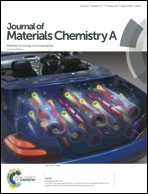Hollow nanocubes composed of well-dispersed mixed metal-rich phosphides in N-doped carbon as highly efficient and durable electrocatalysts for the oxygen evolution reaction at high current densities†
Abstract
The oxygen evolution reaction (OER) received a great deal of research attention in the past few years because of its prime role in electrocatalytic water splitting, rechargeable metal–air batteries, and fuel cells. To be competitively applicable at large scales, the electrocatalytic water-splitting system needs electrocatalysts that are cost effective, highly efficient, and highly durable. A novel metal–organic-framework (MOF)-derived and SiO2-protected phosphorization approach was developed to prepare hollow nanocubes composed of well-dispersed Ni5P4/Fe3P in N-doped carbon as cost-effective OER electrocatalysts, which are highly efficient and durable at high current density operations. Because of their unique structural and compositional features, the N-doped C/Ni5P4/Fe3P hollow nanocubes not only achieved excellent electrocatalytic efficiencies (η10 = 252 mV and η250 = 385 mV), but also outstanding electrocatalytic activities with an ultralow Tafel slope of 24.0 mV dec−1, the lowest ever reported to the best of our knowledge. More importantly, the N-doped C/Ni5P4/Fe3P hollow nanocubes exhibited eminent long-term stability, both electrocatalytically and mechanically, even at a high current density of 250 mA cm−2. These outstanding performances make the developed N-doped C/Ni5P4/Fe3P hollow nanocubes a promising candidate to replace commercial noble metal oxide-based OER electrocatalysts for large-scale applications.



 Please wait while we load your content...
Please wait while we load your content...